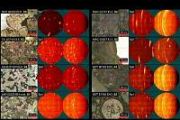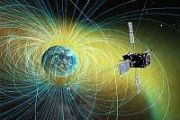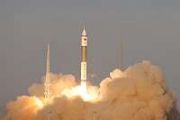
Copernical Team
Record-breaking simulations of large-scale structure formation in the universe
 Current simulations of cosmic structure formation do not accurately reproduce the properties of ghost-like particles called neutrinos that have been present in the Universe since its beginning. But now, a research team from Japan has devised an approach that solves this problem.
In a study published this month in SC '21: Proceedings of the International Conference for High Performance Comp
Current simulations of cosmic structure formation do not accurately reproduce the properties of ghost-like particles called neutrinos that have been present in the Universe since its beginning. But now, a research team from Japan has devised an approach that solves this problem.
In a study published this month in SC '21: Proceedings of the International Conference for High Performance Comp Texas astronomers discover strangely massive black hole in Milky Way satellite galaxy
 Astronomers at The University of Texas at Austin's McDonald Observatory have discovered an unusually massive black hole at the heart of one of the Milky Way's dwarf satellite galaxies, called Leo I. Almost as massive as the black hole in our own galaxy, the finding could redefine our understanding of how all galaxies - the building blocks of the universe - evolve. The work is published in a rece
Astronomers at The University of Texas at Austin's McDonald Observatory have discovered an unusually massive black hole at the heart of one of the Milky Way's dwarf satellite galaxies, called Leo I. Almost as massive as the black hole in our own galaxy, the finding could redefine our understanding of how all galaxies - the building blocks of the universe - evolve. The work is published in a rece Brief presence of water in Arabia Terra on Mars
 NAU PhD candidate Ari Koeppel, as part of a team of scientists from Northern Arizona and Johns Hopkins Universities, recently discovered that water was once present in a unique but brief manner in a region of Mars called Arabia Terra.
Arabia Terra is in the northern latitudes of Mars. Named in 1879 by Italian astronomer Giovanni Schiaparelli, this ancient land covers an area slightly large
NAU PhD candidate Ari Koeppel, as part of a team of scientists from Northern Arizona and Johns Hopkins Universities, recently discovered that water was once present in a unique but brief manner in a region of Mars called Arabia Terra.
Arabia Terra is in the northern latitudes of Mars. Named in 1879 by Italian astronomer Giovanni Schiaparelli, this ancient land covers an area slightly large Onwards and Sidewards for Curiosity on Sol 3313
 The rover rarely drives in a straight line, and our recent drive took the "road less traveled" to investigate a bunch of boulders shed down from a cliff face off to the side of our expected traverse to the south. Why? Beneath the Greenheugh Pediment, the flat-lying, high-standing escarpment to the west, the scientists could see a unique layer with a convoluted texture.
In our drive today,
The rover rarely drives in a straight line, and our recent drive took the "road less traveled" to investigate a bunch of boulders shed down from a cliff face off to the side of our expected traverse to the south. Why? Beneath the Greenheugh Pediment, the flat-lying, high-standing escarpment to the west, the scientists could see a unique layer with a convoluted texture.
In our drive today, Eyes on the Sky
 The Perseverance rover is equipped with a large suite of cameras-23 to be exact-which collectively enable a wide range of scientific investigations and engineering activities. Since the rover's touchdown in Jezero crater, these cameras have served as our eyes on the ground.
In less than a year, the rover has already returned thousands of stunning images of local surface features, which hav
The Perseverance rover is equipped with a large suite of cameras-23 to be exact-which collectively enable a wide range of scientific investigations and engineering activities. Since the rover's touchdown in Jezero crater, these cameras have served as our eyes on the ground.
In less than a year, the rover has already returned thousands of stunning images of local surface features, which hav Vice President Highlights STEM in First National Space Council Meeting
 Vice President Kamala Harris chaired the first National Space Council meeting of the Biden-Harris Administration Wednesday, Dec. 1 at the U.S. Institute of Peace in Washington. Prior to the meeting, President Biden expanded the number of participants of the council by executive order, reflecting the Biden-Harris administration's broad priorities and creating the largest, most diverse space counc
Vice President Kamala Harris chaired the first National Space Council meeting of the Biden-Harris Administration Wednesday, Dec. 1 at the U.S. Institute of Peace in Washington. Prior to the meeting, President Biden expanded the number of participants of the council by executive order, reflecting the Biden-Harris administration's broad priorities and creating the largest, most diverse space counc Test tanks fuelled for ESA's Themis reusable first stage
 Recently completed tests of two propellant tanks set a first technological milestone in the ESA reusability roadmap towards the demonstration of a reusable first stage vehicle called Themis.
Through the Themis programme, ESA aims to assess the economic value of reusability for Europe while investing in new technologies for potential use in ESA's future fleet of launch vehicles.
The T
Recently completed tests of two propellant tanks set a first technological milestone in the ESA reusability roadmap towards the demonstration of a reusable first stage vehicle called Themis.
Through the Themis programme, ESA aims to assess the economic value of reusability for Europe while investing in new technologies for potential use in ESA's future fleet of launch vehicles.
The T NASA Leadership visits Marshall to discuss Artemis, future exploration
 NASA Administrator Bill Nelson and Deputy Administrator Pam Melroy visited the agency's Marshall Space Flight Center in Huntsville on Nov. 29 and 30 for tours and briefings on Marshall's role in the Artemis program and other capabilities that enrich many facets of the nation's space exploration endeavors.
It was their first visit to Marshall in their current roles.
Nelson and Melroy
NASA Administrator Bill Nelson and Deputy Administrator Pam Melroy visited the agency's Marshall Space Flight Center in Huntsville on Nov. 29 and 30 for tours and briefings on Marshall's role in the Artemis program and other capabilities that enrich many facets of the nation's space exploration endeavors.
It was their first visit to Marshall in their current roles.
Nelson and Melroy NASA's Second Pepper Harvest Sets Record on Space Station
 The longest - and perhaps the spiciest - plant experiment in the history of the International Space Station, Plant Habitat-04 (PH-04), concluded recently, 137 days after it began. On Nov. 26, Expedition 66 Flight Engineer Mark Vande Hei harvested and with other members of the crew sampled some of the 26 chile peppers grown from four plants in the orbiting laboratory's Advanced Plant Habitat (APH
The longest - and perhaps the spiciest - plant experiment in the history of the International Space Station, Plant Habitat-04 (PH-04), concluded recently, 137 days after it began. On Nov. 26, Expedition 66 Flight Engineer Mark Vande Hei harvested and with other members of the crew sampled some of the 26 chile peppers grown from four plants in the orbiting laboratory's Advanced Plant Habitat (APH Rocket Lab readies Electron for lift-off in fastest launch turnaround yet
 Rocket Lab USA has revealed its next Electron mission is scheduled to take place during a launch window that opens on December 7, 2021, fewer than three weeks since Rocket Lab's most recent mission on November 18, 2021. These two missions for BlackSky occur 19 days apart and represent Rocket Lab's quickest turnaround in its launch history.
The "A Data With Destiny" mission for BlackSky man
Rocket Lab USA has revealed its next Electron mission is scheduled to take place during a launch window that opens on December 7, 2021, fewer than three weeks since Rocket Lab's most recent mission on November 18, 2021. These two missions for BlackSky occur 19 days apart and represent Rocket Lab's quickest turnaround in its launch history.
The "A Data With Destiny" mission for BlackSky man 





























